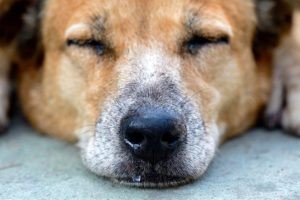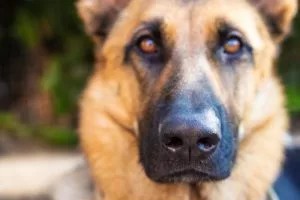Is your furry friend’s nose dripping? Understanding why your dog’s nose is dripping is crucial for their health and well-being. At WHY.EDU.VN, we provide expert insights into the potential causes, ranging from simple allergies to more complex conditions. Discover effective remedies and preventative measures to ensure your canine companion stays happy and healthy. Learn about potential nasal discharge causes, canine nasal drip, and dog nasal health.
1. Common Causes of a Dripping Dog Nose
A dripping nose in dogs can be triggered by various factors. Identifying the root cause is the first step toward providing relief for your beloved pet. Here’s a detailed look at some common culprits:
1.1 Allergies: Seasonal and Environmental
Allergies are a frequent cause of runny noses in dogs. Similar to humans, dogs can be allergic to various substances, leading to nasal drip and other uncomfortable symptoms.
- Seasonal Allergies: Pollens from trees, grasses, and weeds are common seasonal allergens. These allergies often manifest during specific times of the year, causing your dog to experience symptoms such as a runny nose, sneezing, and itchy skin.
- Environmental Allergies: Environmental irritants present year-round can also trigger allergic reactions. Common allergens include dust mites, mold spores, and dander.
- Food Allergies: Although less common, food allergies can also cause nasal drip. Common culprits include beef, chicken, dairy, and wheat.
Symptoms of Allergies in Dogs
| Symptom | Description |
|---|---|
| Runny Nose | Clear or slightly discolored nasal discharge. |
| Sneezing | Frequent sneezing, often accompanied by nasal congestion. |
| Itchy Skin | Excessive scratching, licking, or chewing, especially around the paws, ears, and groin. |
| Watery Eyes | Red, irritated eyes with excessive tearing. |
| Coughing | Persistent coughing, which may indicate post-nasal drip. |
| Facial Swelling | Swelling around the face, particularly the muzzle and eyes. (Seek immediate veterinary attention if present) |


1.2 Irritants: Environmental Factors
Environmental irritants can directly affect your dog’s nasal passages, leading to inflammation and nasal drip. Identifying and minimizing exposure to these irritants is crucial.
- Smoke: Cigarette smoke, wood smoke, and even smoke from cooking can irritate a dog’s nasal passages.
- Chemicals: Household cleaning products, perfumes, and air fresheners can contain chemicals that cause irritation.
- Dust: Dust and dust mites can be significant irritants, particularly for dogs with allergies.
- Pollution: Air pollution, including smog and particulate matter, can also contribute to nasal irritation.
1.3 Infections: Bacterial, Viral, and Fungal
Infections are another common cause of nasal drip in dogs. These infections can be bacterial, viral, or fungal and often require veterinary intervention.
- Bacterial Infections: Bacterial infections in the nasal passages can cause thick, discolored nasal discharge. These infections often result from secondary issues such as foreign bodies or dental disease.
- Viral Infections: Viral infections, such as canine influenza or kennel cough, can cause a clear to milky nasal discharge. These infections are often accompanied by other symptoms, such as coughing and fever.
- Fungal Infections: Fungal infections, such as aspergillosis, can cause chronic nasal drip and are more common in certain breeds. These infections often require long-term treatment.
1.4 Foreign Bodies: Nasal Obstructions
Dogs are curious creatures, and their noses often lead them into trouble. Foreign objects can become lodged in their nasal passages, leading to irritation and nasal drip.
- Plant Material: Grass seeds, twigs, and other plant material can easily become lodged in a dog’s nose, especially during outdoor activities.
- Small Objects: Small toys, food particles, or other objects can be inhaled and become trapped in the nasal passages.
Signs of a Foreign Body in a Dog’s Nose
| Sign | Description |
|---|---|
| Unilateral Discharge | Nasal drip that occurs from only one nostril is a strong indicator of a foreign body. |
| Frequent Sneezing | Sudden, intense sneezing fits are common as the dog attempts to dislodge the object. |
| Pawing at the Nose | The dog may paw or rub at their nose in an attempt to relieve the irritation. |
| Nosebleeds | The nasal passages can become irritated and bleed, resulting in nosebleeds. |
| Facial Swelling | In some cases, the presence of a foreign body can lead to inflammation and swelling around the nose and face. |
| Difficulty Breathing | If the foreign body obstructs the airway, the dog may experience difficulty breathing. (Seek immediate veterinary attention if present) |
1.5 Nasal Tumors: A Serious Concern
Nasal tumors, though less common, can cause chronic nasal drip in dogs. These tumors can be benign or malignant and often require aggressive treatment.
- Symptoms: Common symptoms of nasal tumors include chronic nasal discharge, nosebleeds, facial swelling, and difficulty breathing.
- Diagnosis: Diagnosis typically involves imaging studies such as X-rays or CT scans, as well as biopsies.
- Treatment: Treatment options may include surgery, radiation therapy, and chemotherapy.
1.6 Dental Issues: Periodontal Disease
Dental issues, particularly periodontal disease, can sometimes lead to nasal drip in dogs. The close proximity of the nasal passages to the oral cavity means that infections in the mouth can spread upwards.
- Mechanism: Periodontal disease can cause inflammation and infection that erode the bone separating the nasal passages from the tooth roots.
- Symptoms: Nasal discharge resulting from dental issues is often chronic and may contain pus or blood.
- Prevention: Regular dental care, including brushing and professional cleanings, is essential for preventing periodontal disease.
1.7 Breed Predisposition: Brachycephalic Breeds
Certain breeds of dogs are more prone to nasal drip due to their unique anatomy. Brachycephalic breeds, characterized by their short noses and flat faces, often experience breathing difficulties that can lead to nasal discharge.
- Common Breeds: Examples of brachycephalic breeds include Bulldogs, Pugs, Boxers, and French Bulldogs.
- Anatomical Issues: Their compressed nasal passages and elongated soft palates can cause chronic irritation and nasal drip.
- Management: Management strategies include weight control, avoiding strenuous exercise in hot weather, and surgical correction of anatomical abnormalities.
2. Diagnosing the Cause of a Dripping Nose
Determining the precise cause of your dog’s runny nose involves a thorough examination and, in some cases, diagnostic testing. Here’s what you can expect during the diagnostic process:
2.1 Physical Examination: Initial Assessment
Your veterinarian will start with a comprehensive physical examination. This includes:
- Observation: Observing the nature of the nasal discharge (color, consistency, and whether it’s from one or both nostrils).
- Palpation: Feeling the dog’s face for any signs of swelling or pain.
- Auscultation: Listening to the dog’s lungs to rule out respiratory issues.
- Dental Exam: Checking for signs of dental disease.
2.2 Diagnostic Tests: Advanced Evaluation
Depending on the initial assessment, your vet may recommend further diagnostic tests to pinpoint the cause of the nasal drip.
- Rhinoscopy: This procedure involves using a small camera to visualize the nasal passages. It can help identify foreign bodies, tumors, or other abnormalities.
- Cytology: Collecting a sample of the nasal discharge to examine under a microscope. This can help identify infections or inflammatory cells.
- Bacterial Culture: Culturing the nasal discharge to identify any bacterial infections and determine the appropriate antibiotics.
- Fungal Culture: Culturing the nasal discharge to identify any fungal infections.
- Allergy Testing: Performing allergy tests to identify specific allergens. This can involve skin testing or blood tests.
- Imaging Studies: X-rays, CT scans, or MRIs can help visualize the nasal passages and identify tumors or other structural abnormalities.
- Biopsy: Taking a tissue sample for analysis to diagnose tumors or other conditions.
3. Treatment Options for a Dog’s Runny Nose
Once the cause of the nasal drip is identified, your veterinarian will recommend an appropriate treatment plan. Treatment options vary depending on the underlying condition.
3.1 Allergy Management: Reducing Exposure
If allergies are the cause, managing your dog’s exposure to allergens is crucial. This can involve:
- Avoiding Allergens: Limiting exposure to pollens, dust mites, and other allergens.
- Air Purifiers: Using air purifiers to remove allergens from the air.
- Regular Cleaning: Regularly cleaning your home to reduce dust and mold.
- Bathing: Regularly bathing your dog to remove allergens from their coat.
3.2 Medication: Antihistamines and Decongestants
Medications can help relieve allergy symptoms and reduce nasal drip.
- Antihistamines: Antihistamines can help reduce itching, sneezing, and nasal drip caused by allergies.
- Decongestants: Decongestants can help relieve nasal congestion. (Use with caution and under veterinary guidance)
3.3 Antibiotics and Antifungals: Treating Infections
If your dog has a bacterial or fungal infection, antibiotics or antifungals will be necessary.
- Antibiotics: Antibiotics are used to treat bacterial infections. The choice of antibiotic will depend on the specific bacteria identified.
- Antifungals: Antifungals are used to treat fungal infections. These medications often require long-term administration.
3.4 Surgery: Removing Foreign Bodies and Tumors
Surgery may be necessary to remove foreign bodies or tumors from the nasal passages.
- Foreign Body Removal: Surgery can be used to remove foreign bodies that cannot be removed with rhinoscopy.
- Tumor Removal: Surgery may be an option for removing nasal tumors, although it is not always possible to remove the entire tumor.
3.5 Dental Care: Addressing Periodontal Disease
If periodontal disease is the cause of the nasal drip, addressing the dental issues is crucial.
- Professional Cleaning: Professional dental cleanings can help remove tartar and plaque from the teeth.
- Tooth Extractions: Severely affected teeth may need to be extracted.
- Home Dental Care: Regular brushing and dental chews can help prevent periodontal disease.
4. Home Care Tips for a Dog with a Runny Nose
In addition to veterinary treatment, there are several things you can do at home to help your dog feel more comfortable.
4.1 Humidifiers: Soothing Nasal Passages
Using a humidifier can help moisten the air and soothe irritated nasal passages.
- Benefits: Humidifiers can help relieve nasal congestion and make it easier for your dog to breathe.
- Maintenance: Be sure to clean the humidifier regularly to prevent mold growth.
4.2 Nasal Flush: Clearing Congestion
A nasal flush can help clear congestion and remove irritants from the nasal passages.
- Saline Solution: Use a sterile saline solution specifically designed for nasal irrigation.
- Technique: Gently flush each nostril with the saline solution, following your veterinarian’s instructions.
4.3 Warm Compress: Relieving Discomfort
Applying a warm compress to your dog’s nose can help relieve discomfort and reduce inflammation.
- Application: Soak a clean cloth in warm water and gently apply it to your dog’s nose for a few minutes at a time.
- Frequency: Repeat this several times a day.
4.4 Monitoring: Tracking Symptoms
Keep a close eye on your dog’s symptoms and report any changes to your veterinarian.
- Note Symptoms: Keep a record of the frequency and severity of the nasal drip, as well as any other symptoms.
- Report Changes: Notify your vet if the nasal drip worsens, changes color, or is accompanied by other concerning symptoms.
5. Understanding the Different Types of Nasal Discharge
The characteristics of your dog’s nasal discharge can provide valuable clues about the underlying cause. Here’s a breakdown of what different types of discharge might indicate:
5.1 Clear Nasal Discharge
Clear nasal discharge often indicates mild irritation or allergies. It can also be seen in the early stages of viral infections.
- Common Causes: Allergies, mild irritants (dust, pollen), early viral infections.
- What to Do: Monitor your dog’s symptoms and try to identify potential irritants or allergens. If the discharge persists or worsens, consult your veterinarian.
5.2 White or Milky Nasal Discharge
White or milky nasal discharge may suggest a mild bacterial infection or inflammation in the nasal passages.
- Common Causes: Mild bacterial infections, inflammation.
- What to Do: Monitor your dog closely. If the discharge thickens, changes color, or is accompanied by other symptoms (coughing, sneezing, fever), consult your veterinarian.
5.3 Yellow or Green Nasal Discharge
Yellow or green nasal discharge typically indicates a more severe bacterial infection. The color comes from the presence of white blood cells fighting off the infection.
- Common Causes: Bacterial infections.
- What to Do: Consult your veterinarian immediately. Your dog likely needs antibiotics to clear the infection.
5.4 Bloody Nasal Discharge
Bloody nasal discharge can be alarming and may indicate several serious conditions.
- Common Causes: Trauma, foreign body in the nasal passage, nasal tumors, fungal infections, bleeding disorders.
- What to Do: Consult your veterinarian immediately. Prompt diagnosis and treatment are essential.
5.5 One-Sided vs. Two-Sided Nasal Discharge
Whether the nasal discharge is coming from one nostril or both can also provide important clues.
- One-Sided (Unilateral) Discharge: Often indicates a localized problem, such as a foreign body, dental issue, or nasal tumor.
- Two-Sided (Bilateral) Discharge: More commonly associated with systemic issues like infections, allergies, or irritants affecting both nasal passages.
6. Preventing a Dripping Nose in Dogs
While not all causes of a runny nose can be prevented, there are several steps you can take to reduce your dog’s risk.
6.1 Regular Veterinary Checkups: Early Detection
Regular veterinary checkups are essential for detecting health problems early on.
- Importance: Your veterinarian can identify potential issues before they become serious and provide guidance on preventative care.
- Frequency: Follow your veterinarian’s recommendations for checkup frequency, which may vary depending on your dog’s age and health.
6.2 Vaccinations: Protecting Against Infections
Vaccinations can protect your dog against several infectious diseases that can cause nasal drip.
- Core Vaccines: Ensure your dog is up-to-date on core vaccines, such as distemper, parvovirus, adenovirus, and rabies.
- Lifestyle Vaccines: Discuss lifestyle vaccines, such as canine influenza and Bordetella (kennel cough), with your veterinarian.
6.3 Good Hygiene: Maintaining a Clean Environment
Maintaining good hygiene can help reduce your dog’s exposure to irritants and allergens.
- Regular Cleaning: Regularly clean your home to reduce dust, mold, and other allergens.
- Bedding: Wash your dog’s bedding regularly.
- Grooming: Regularly groom your dog to remove allergens from their coat.
6.4 Dental Care: Preventing Periodontal Disease
Good dental care is essential for preventing periodontal disease, which can lead to nasal drip.
- Brushing: Brush your dog’s teeth regularly.
- Dental Chews: Provide dental chews to help remove tartar and plaque.
- Professional Cleanings: Schedule professional dental cleanings as recommended by your veterinarian.
6.5 Avoiding Irritants: Minimizing Exposure
Minimizing your dog’s exposure to irritants can help prevent nasal drip.
- Smoke-Free Environment: Avoid exposing your dog to cigarette smoke or other types of smoke.
- Safe Cleaning Products: Use pet-safe cleaning products.
- Limit Outdoor Exposure: Limit outdoor exposure during peak allergy season.
7. When to See a Veterinarian
While a mild, occasional runny nose may not be cause for concern, certain symptoms warrant a visit to the veterinarian.
- Persistent Nasal Drip: If the nasal drip persists for more than a few days.
- Discolored Discharge: If the nasal discharge is yellow, green, or bloody.
- Difficulty Breathing: If your dog is having difficulty breathing.
- Facial Swelling: If your dog has facial swelling.
- Loss of Appetite: If your dog has lost their appetite.
- Lethargy: If your dog is lethargic or weak.
- Other Symptoms: If your dog has other symptoms, such as coughing, sneezing, or fever.
8. The Role of Nutrition in Nasal Health
A balanced diet is critical for maintaining your dog’s overall health, including the health of their nasal passages. Certain nutrients can help support the immune system and reduce inflammation.
8.1 Essential Fatty Acids
Omega-3 and omega-6 fatty acids play a crucial role in reducing inflammation and supporting the immune system.
- Sources: Fish oil, flaxseed oil, and other supplements.
- Benefits: Reducing inflammation can help alleviate allergy symptoms and improve overall nasal health.
8.2 Antioxidants
Antioxidants help protect cells from damage caused by free radicals, supporting the immune system.
- Sources: Vitamins C and E, beta-carotene, and selenium.
- Benefits: Strengthening the immune system can help prevent infections and reduce inflammation.
8.3 Probiotics
Probiotics support a healthy gut microbiome, which plays a crucial role in immune function.
- Sources: Yogurt, kefir, and probiotic supplements.
- Benefits: Improving gut health can enhance the immune system and reduce inflammation.
9. Advanced Diagnostic Procedures: When More Information is Needed
In some cases, initial diagnostic tests may not provide a clear answer. When this happens, your veterinarian may recommend more advanced procedures to get a clearer picture of what’s going on.
9.1 Computed Tomography (CT) Scans
CT scans provide detailed cross-sectional images of the nasal passages, allowing veterinarians to visualize abnormalities that may not be visible on X-rays.
- What to Expect: Your dog will be placed under anesthesia for the CT scan. The procedure is non-invasive and relatively quick.
- Benefits: Detailed images can help identify tumors, foreign bodies, and other structural abnormalities.
9.2 Magnetic Resonance Imaging (MRI)
MRI provides even more detailed images than CT scans, particularly of soft tissues. This can be especially useful for diagnosing nasal tumors.
- What to Expect: Similar to CT scans, your dog will be placed under anesthesia for the MRI.
- Benefits: High-resolution images can help identify and characterize nasal tumors, as well as other soft tissue abnormalities.
9.3 Bronchoscopy
If your veterinarian suspects that the nasal drip may be related to a lower respiratory tract issue, they may recommend a bronchoscopy. This procedure involves inserting a small camera into the airways to visualize the trachea and bronchi.
- What to Expect: Your dog will be placed under anesthesia for the bronchoscopy.
- Benefits: Can help identify infections, inflammation, or other abnormalities in the lower respiratory tract.
10. Innovative Treatments on the Horizon
Veterinary medicine is constantly evolving, and new treatments for nasal conditions in dogs are always being developed. Here are a few innovative approaches to keep an eye on:
10.1 Immunotherapy for Allergies
Immunotherapy, also known as allergy shots, involves gradually exposing your dog to small amounts of allergens to desensitize their immune system.
- How it Works: Regular injections of allergens help the body build tolerance over time.
- Benefits: Can provide long-term relief from allergy symptoms and reduce the need for medication.
10.2 Stem Cell Therapy
Stem cell therapy is being explored as a potential treatment for various inflammatory conditions, including chronic rhinitis.
- How it Works: Stem cells are injected into the affected area to promote healing and reduce inflammation.
- Benefits: May help reduce chronic inflammation and improve nasal health.
10.3 Gene Therapy
Gene therapy is a cutting-edge approach that involves modifying genes to treat disease. While still in the early stages of development, gene therapy holds promise for treating certain genetic conditions that can affect nasal health.
- How it Works: Modifying genes to correct abnormalities.
- Benefits: Potential to correct underlying genetic causes of nasal conditions.
A dripping nose in dogs can be caused by a variety of factors, ranging from simple allergies to more complex conditions. By understanding the potential causes, recognizing the symptoms, and working closely with your veterinarian, you can help your furry friend stay healthy and comfortable.
Remember, early detection and prompt treatment are key to managing nasal conditions in dogs. If you have any concerns about your dog’s nasal health, don’t hesitate to seek veterinary care.
Are you seeking expert advice for your dog’s health concerns? Visit why.edu.vn today to ask questions and connect with experienced professionals. Our team is dedicated to providing reliable, accurate information to help you make informed decisions about your pet’s well-being. Contact us at 101 Curiosity Lane, Answer Town, CA 90210, United States, or WhatsApp at +1 (213) 555-0101. Your pet’s health is our priority.
Frequently Asked Questions (FAQ)
-
Why is my dog’s nose dripping clear liquid?
A clear nasal discharge is often due to allergies, mild irritants, or early stages of a viral infection. Monitor your dog for other symptoms and consult your vet if it persists.
-
What does it mean if my dog’s nose is dripping green?
Green nasal discharge typically indicates a bacterial infection. You should consult your veterinarian for treatment, which usually involves antibiotics.
-
Can allergies cause my dog’s nose to drip?
Yes, allergies are a common cause of nasal drip in dogs. Seasonal and environmental allergies can trigger a runny nose along with other symptoms like sneezing and itchy skin.
-
Is it normal for certain dog breeds to have a runny nose?
Yes, brachycephalic breeds (like Bulldogs and Pugs) are more prone to runny noses due to their compressed nasal passages. Hunting dogs also have increased risk as their noses are closer to the ground.
-
What should I do if I see blood in my dog’s nasal discharge?
Bloody nasal discharge can be a sign of a serious condition such as trauma, foreign body, or tumor. Consult your veterinarian immediately.
-
How can I prevent my dog from getting a runny nose?
Prevention includes regular vet checkups, vaccinations, maintaining good hygiene, providing proper dental care, and avoiding irritants.
-
What home remedies can I use for my dog’s runny nose?
You can use a humidifier, saline nasal flush, and warm compresses to relieve discomfort. Always consult your vet before starting any home treatment.
-
Can dental issues cause my dog’s nose to drip?
Yes, periodontal disease can lead to nasal drip. Inflammation and infection from dental problems can spread to the nasal passages.
-
What tests might my vet do to find out why my dog’s nose is dripping?
Your vet might perform a physical examination, rhinoscopy, cytology, bacterial or fungal cultures, allergy testing, imaging studies, or a biopsy.
-
When is a runny nose in a dog considered an emergency?
A runny nose is an emergency if accompanied by difficulty breathing, facial swelling, loss of appetite, lethargy, or discolored discharge. Seek immediate veterinary care.

